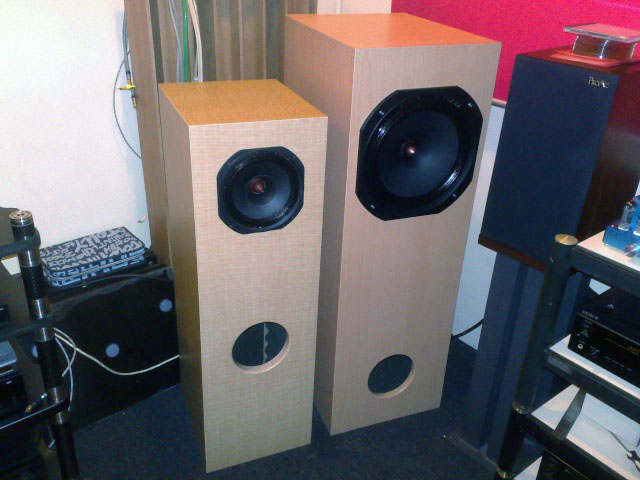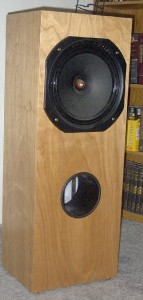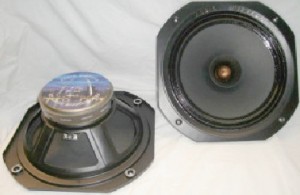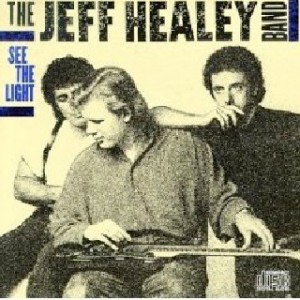There are several distinct benefits to a speaker system that utilizes a single driver per side. Blending two or more drivers together through a crossover network is a difficult task. A multidriver speaker has issues with crossover slopes, speaker phase, impedance matching, and differing sound radiation patterns. A full range driver in a properly executed design will sidestep the problems associated with a traditional multi-driver speaker. Common-Sense Audio offers the Audio Nirvana line of full range drivers. The smallest driver in the Audio Nirvana family is a 6.5-inch speaker. Recently, a 12-inch full range behemoth has been added to the line-up. In February 2007, we reviewed the Audio Nirvana Super 8 driver. This speaker had several commendable traits, and offered s rock solid value to the frugal audio enthusiast. When David Dicks announced the addition of the Super 12 to the Audio Nirvana lineup, I immediately ordered a pair of these drivers for review.
Audio Nirvana Super 12 review
There are hundreds of full range drivers available to the do-it-yourself speaker builder. The size of these drivers typically falls between 4 and 8 inches in diameter. The Nirvana Super 12 is a titan when compared to the other full range drivers in the marketplace. An accordion surround is used on this speaker, which is superior to the typical foam usually found on drivers at the same price point. The Super 12 driver utilizes a whizzer cone, which is partially responsible for reproducing high frequency information. This driver design allows the voice coil to radiate high frequency energy through a gap between the inner edge of the diaphragm and the pole piece. A copper-colored phase plug rests in the center of the driver to control early reflection issues within the whizzer cone. The Super 12 uses a stamped steel frame, which is attached to a 49.7 oz ferrite magnet. This driver employs a 1.5-inch voice coil
Finding a suitable cabinet is the first issue that needed to be resolved. There are several commercially produced cabinets available to the DIY crowd, however none of them have a wide enough baffle to accommodate a 12-inch driver. While I have built my own cabinets in the past, I did not have access to a high quality table saw for this project. Instead, I contacted Jason Flanary at Lovecraft Designs about the possibility of building a cabinet for me. (1) Jason is an extremely busy guy, but he was kind enough to take on this project. The cabinets were built to the specifications provided by CommonSense Audio. Birch plywood was used, and a water based polyurethane finish was applied. Jason cut the openings for the driver, and a 6-inch port. T-Nuts were put in place so that the driver could be firmly bolted down. The unique Cain and Cain brass spikes were installed on the bottom of the cabinet. Jason did a fantastic job building these cabinets, and the distinctive Cain and Cain appearance is clearly evident.
With the cabinets finished, the final assembly steps could proceed. Cardas binding posts were installed on the rear of the speakers. The port tube needed to be cut down to a 3-inch length before being mounted. Two and a half inches of Dacron batting was fitted in the inside of the cabinet, except for the front plate. I soldered cryogenically treated 16 gauge magnet wire to the drivers and the binding posts. The Super 12 drivers were bolted in place, and now the break-in process could begin. I played the speakers at normal listening volumes for 100 hours before I started to analyze their performance. In this configuration, these speakers had the sonic attributes of an 80’s era British loudspeaker. They sounded nothing like the Audio Nirvana Super 8’s that I had listened to before. Clearly, there was work that I needed to do to these speakers.
Three basic changes were made to these speakers before I was satisfied with their performance. The internal wiring was the first area that needed to be addressed. I installed several different types of wire, and evaluated the changes in the speaker’s character. The cryogenically treated magnet wire had fantastic detail and imaging abilities, but unfortunately had diminished bass response. A 16-guage solid core copper wire gave this speaker a romantic presentation. Vocals were full and lush; while the bass had an excessive amount of bloom. A silver ribbon wire from Audio Magic resulted in the best all around performance. This wire turned in a remarkable performance across the audio spectrum. The other configurations excelled in certain areas, but fell short of the overall abilities of the Audio Magic wire. The internal wire is the largest variable affecting the overall performance of this driver. Be prepared to experiment with a few different types of wire in order to voice this speaker to your satisfaction.
David Dicks recommends a bass reflex cabinet design for the Audio Nirvana drivers. This method of driver loading is easy to build, and offers just enough low frequency reinforcement to achieve an even tonal balance for this speaker. I discovered that the amount of damping material used inside the cabinet also has a significant impact on the tonal character of the Audio Nirvana driver. The two and a half inches of Dacron batting was responsible for this speaker emulating a traditional British loudspeaker. (2) It was evident that I needed to reduce the amount of dampening material in this speaker. I removed a good portion of the Dacron batting, and began the process of evaluating the effects of this change. It became evident that one inch of material was insufficient to dampen the cabinet resonance. I re-installed the Dacron batting in half-inch increments, and listened to the corresponding changes. The arrangement that I settled on has two inches of material on the rear wall. The sides and top/bottom plate are covered with one and a half inches of batting. This configuration maintains the lively and dynamic character of the Audio Nirvana driver, yet effectively removes any cabinet vibrations. It is clearly evident that the amount of damping material in the cabinet will exert a noticeable influence on the sound of the Super 12 driver.
The final adjustment I made to these speakers was to change the length of the port. The first port has a six-inch diameter, and three inches long. After several listening sessions, I decided to lower the tuning frequency of the port. The three-inch port is tuned too high, and its output obscured the detail of low frequency instruments. After speaking with David Dicks, I decided to install a 6-inch long port. The new port removes some mid-bass energy from the speaker, yet still provides the necessary reinforcement of the lowest octaves. While adjusting the port length is a fairly minor change in the voicing of this speaker, it does solve a minor issue that had crept up during the final tuning stages. Significant performance gains can be obtained from the Super 12 driver if an audio enthusiast is willing to take the time to evaluate different combinations of the parts required to build this speaker.
Due to the high efficiency of the Audio Nirvana Super 12 driver, this speaker system works well with lower powered amplifiers. A 13-watt per channel Electra-Print 300DRD amplifier is used to drive these speakers. (3) An Electra-Print PVA carried out pre-amplifier duties in this system. The digital source is an Audio Magic Kukuma DAC, which is paired with a JVC XL-Z1050TN CD player. Cables from the Audio Magic Illusion 4D line made all the necessary connections between components. Audio Magic Extreme power cords are used on any component fitted with an IEC connector. Finally, a Monarchy Audio AC Regenerator provided clean power to the digital pieces.
The Audio Nirvana speakers are fairly easy to place in a room. I spread these speakers nine feet apart, and then toed them in. The output of a full range driver tends to be directional, so it is important to “aim” them at the listening position. The toe-in I applied to the speakers sighted the phase plug at a point just over my shoulder. While this speaker creates a large sweet spot, minor differences in high frequency performance can be heard by altering the toe-in angle of this speaker. (4) The tonal balance of the Audio Nirvana speaker benefits from being loaded on a wall. After a bit of experimentation, I settled on placing these cabinets fourteen inches from the rear wall. This speaker projects the soundstage into a room, so its performance does not suffer from being situated near the room boundaries. Audio enthusiasts with dual-purpose rooms may appreciate this attribute. It is possible to properly set up these speakers without having to dedicate a significant amount of floor space to them.
A well-executed full range speaker is a textbook example of the KISS theory. The Audio Nirvana driver does not use a crossover network, and therefore avoids all the frequency and phase issues found in a conventional speaker system. The Super 12 speaker excels in midrange, with purity that is the hallmark of a good full range driver. “Only A dream” by Mark Chapin-Carpenter [Come On Come On; Columbia CK 48881] highlights the impressive abilities of this speaker. The piano has a delicate texture, and a natural tonal balance across all octaves. Individual notes hang in the air, and slowly resolve as the next one is struck. Carpenter’s vocals are expressive, with all the subtle detail that is captured in a closely miked recording. The Super 12 driver is capable of portraying the emotional content of this song, and does an excellent job of relaying the story that Carpenter weaves. The Audio Nirvana driver performs well in many areas, but the midrange presentation is clearly its greatest strength.
Muscle car enthusiasts have a saying, “there is no replacement for displacement”. In some respects, this line of reasoning can be applied to the Super 12 driver. The large surface area of this cone allows this speaker to develop high output levels and deep bass response. This can be achieved in a simple cabinet, whereas smaller full range drivers need to resort to complex enclosures such as voight pipes, or back loaded horns in order to achieve similar results. One of the most difficult tasks for a speaker to accomplish is to recreate the complexity of classical music. “Fanfare for the Common Man” by Aaron Copeland [Appalachian Spring; NAXOS 8.550282] opens with a majestic combination of tympani drums and trumpets. The power and weight of the tympani drums are clearly reproduced by the Audio Nirvana driver. Even though the low bass instruments require the driver to move large volumes of air, the subtle detail of the decay of each note is clearly heard. The Super 12 drivers do not fall victim to the one note bass syndrome. This speaker is capable of providing excellent detail in the lower registers of a song, and function quite well as a standalone speaker system.
Audio reviewers spend a great deal of time dissecting the performance of any component that wanders into their listening room. While this is undoubtedly a noble pursuit, it is important to decide at the end of the day if the perspective component makes music fun to listen to. This attribute is easy to experience, but it can be quite difficult to describe to another audio enthusiast. Even though the Audio Nirvana speaker system does a fine job of extracting the subtle detail out of a song, it never strips the music of its character. “Confidence Man” by the Jeff Healey Band [See the Light; Arista ARCD-8553] is a great blues song that anyone can jam to. The bass guitar and drum kit set a powerful backbeat on this track. Healey grinds out one catchy guitar hook after another. If you can’t appreciate this song, then check your pulse because you might be dead. The Super 12 drivers relay all the energy and enthusiasm contained in this track. When a good blues disc is played, either a speaker is going to get the music right, or it is going to miss the mark. There is no in between in this scenario. At the end of the day, the Audio Nirvana speakers are just plain fun.
Loudspeakers are never perfect; every one of them has a combination of strengths and limitations. The Audio Nirvana Super 12 driver effectively sidesteps the majority of the limitations found in traditional full range drivers. While this speaker does a nice job of extracting low-level detail from a recording, the higher frequencies do not approach the level of refinement that an esoteric tweeter can achieve. The overall character of this speaker can described as vibrant and energetic. The Super 12 values the ebb and flow of the music, over pure detail retrieval. Since this speaker is going to be used in a DIY application, it is important to emphasis that the builder’s selection of materials will greatly affect the final outcome. The final sound can be significantly influenced by the choice of wire, thickness of damping material, and port length. When the cost of the Super 12 drivers is thrown into the equation, these speakers are an amazing value.
Conclusions about Audio Nirvana Super 12
Audio Nirvana offers the only twelve-inch full range driver that I am aware of. This driver has the enviable combination of high efficiency and low frequency extension. Throw in the fact that the Super 12 driver requires a simple bass reflex cabinet, and then the true worth of these speakers can be realized. The Audio Nirvana drivers are a complete package, and reproduce all facets of the audio spectrum with a high level of competence. Midrange performance is top shelf, and this speaker will stand toe to toe with many of the highly regarded speakers in the marketplace. The Super 12 has excellent bass extension, due to the cabinet size and the large surface area of the driver. This speaker is well suited to work in a wide variety of systems. The Audio Nirvana speakers will work well with a SET amplifier, chip amp, or even a vintage receiver.(5) The Super 12 driver is just the ticket for the audio enthusiast who is working with limited funds in their audio kitty. With a little bit of sweat equity, a fine speaker system can be had for a modest price. David Dicks has an excellent product, and I expect that the Audio Nirvana drivers will have a successful future.
Notes
1 Jason Flanary was the protégé of Terry Cain. When Terry passed away, Jason carried on the production of Cain&Cain speakers. Terry and
Jason built beautiful speakers, and Jason should be applauded for carrying on his mentors work.
2 There is nothing wrong with the British ‘sound’ of the 80’s and 90’s. However, I could have just gone to the used market for a pair of KEF or
Linn speakers.
3 In keeping with the spirit of the Audio Nirvana Super 8 review, I also listened to these speakers with a Monarchy Audio SM 70 PRO amplifier. This is a 30-wpc solid sate amplifier.
4 Even though the driver has directional characteristics. It does not have the beaming issues many Electrostatic speakers have. A person can
walk around the listening room and still enjoy the full spectrum of the music.
5 Don’t get me wrong; this is a high performance speaker. I have used it with 80 wpc of Class A power, and achieved excellent results. I also had this speaker over to a fellow reviewers home, and installed them into a $25,000 system. His comment? Reminds me of his previous speaker, the
Zu Druids. He couldn’t get over the great sound of this speaker.
 from affordableaudio, By John Hoffman
from affordableaudio, By John Hoffman





Hi
Thank you very much for reviewing the Audio Nirvana speakers. I am also having a AN 12″ ferrite speaker pair and I am using it around a year now. After reading your review I repositioned my speakers accordingly and found I am more comfortable with the given spec. Thank you very much for sharing your experience.